Gamebox 2.0: Games of September 2021
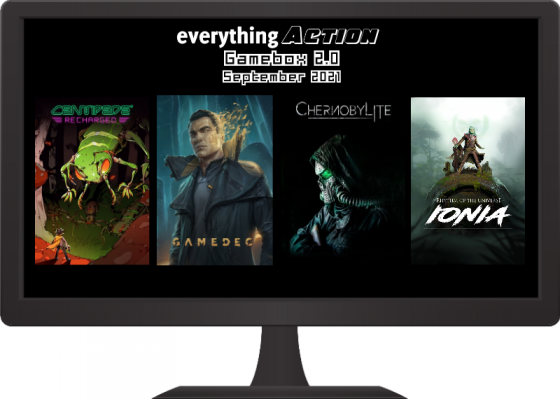
September is here and it’s time to get educated with new game reviews. We got to check out a remix of an arcade classic with Centipede: Recharged, ventured into a radioactive wasteland in Chernobylite, solved mysterious game-breaking cases in Gamedec, and explored a lush alien forest in Ionia. Check out our impressions and review below in the latest Gamebox 2.0
Centipede: Recharged (Zach): The first in Atari’s “Recharged” series that has updated versions of Asteroids, Breakout, and Black Widow coming soon (Black Widow is out on October 28th), iconic arcade classic Centipede comes to modern consoles with a neon-tinged version reminiscent of Geometry Wars. Centipede: Recharged has the same basic gameplay as the arcade original where you control the Bug Blaster in a specified zone on the bottom of the screen. Centipedes come from the top of the screen and your job is to blast them away to earn points. If you shoot in the middle of the Centipede, you’ll split in two but if you shoot its head, the next segment back becomes the new head but it remains one piece.
Accuracy is important so that you don’t find yourself overwhelmed with new Centipedes. The other baddies like Spiders, Fleas, and Scorpions are back as well although you will probably be glad to see the Spiders this time around as they are the ones who give you all the new power-ups. There’s a wide range of power-ups from rapid-fire and spread shots to more interesting ones like getting bombs placed onto the map that can kill multiple enemies when shot, a mirrored Bug Blaster on the top of the screen so you can shoot from both sides of the screen and a ghost that scares all the Centipedes on the board away to potentially give you some breathing room.
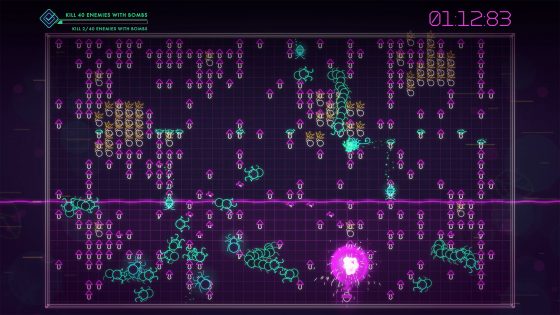
One big difference that major Centipede fans will probably notice and might balk at a bit is the playfield. The original was a very vertical game but Centipede: Recharged makes the game more horizontal with a playfield that was designed for modern widescreen TVs. It does seem like the wideness of the field will let more Centipedes invade your movement zone but it’s also wide enough where you have room to maneuver and escape them. Along with a classic Arcade mode that you can play single-player or co-op, there are also a ton of challenges that really do a great job of adding new ways to play and think about Centipede.
Some of the missions are about clearing mushrooms, some focus on other enemies besides the Centipedes and some have unique and challenging map layouts. As you play through challenges, you’ll unlock more and there are 30 challenges in total to complete and improve your score on. If you’re a fan of Centipede, Recharged is a fun update that keeps most of the classic gameplay but the challenges really shake things up and will make you play and think differently even if you’ve mastered the original arcade classic. Centipede: Recharged is out on pretty much everything including PS4/PS5, Switch, Xbox, Steam, Epic Games, and the Atari VCS.
Gamedec (Chris): When there is suspicious activity in the virtual world, game detectives will bridge the gap between reality and simulation. Developed by Anshar Studios and published by Anshar Publishing, Gamedec is an isometric RPG, set in a cyberpunk future where artificial worlds have become integrated with the real world. People have begun to take entertainment, lifestyles, and businesses to a new virtual space for everyone to explore. But behind the high res graphics and immersive experiences, there is an underworld of nefarious hustles that have stolen fortunes and taken lives. Private detectives known as a Gamedec use their wits, charms, and cyber hacks to investigate and the truth in the cyberspace.
The game puts you into the role of fully customization gamedec that lets you choose the background and playstyle. You can select the detective to come from a high-class upbringing, common middle class, or someone that has meager beginnings. This will affect how the gamedec perspectives and how conversation flow. You can build up skills that allow for more enhancements to perform tasks easier, glitch environments, and probe information further. Every decision is affected by how the gamedec present themselves, with rippling consequences for every action.
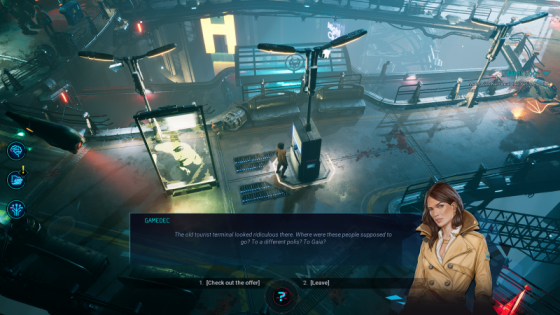
The plot of Gamedec follows a series of cases and side quests that players will be asked to be solved. Each main case will take the gamedec to a unique landscape that has its own themes, game elements, and troubles. Based on the case, the gamedec has a variety of options to investigate, usually starting with interviewing characters and looking for obvious clues. The gameplay really opens up by how to approach each situation. Based on the earlier decisions, you can bypass activities and have critical info ahead of time. Solving mysterious doesn’t always mean having all the right answers or being correct to make a conclusion. You can have all the wrong evidence and somehow find a way to the truth. Or be completely wrong and close out a case with an unsatisfied client.
While it game looks like it offers endless possibilities to take on every challenge, but it is easy to blow past information discoveries and chat options. There is a pacing issue that makes the deduction selections sometimes feel like a test of trial and error, especially on the first play thru. As the game gets the rhythm of allowing the player to feel like a hard boil detective or a bumbling fixer, Gamedec bottlenecks the experience by having a linear path nearly halfway in the game. This does heavy dim the shiny premise it boosts.
Gamedec does offer a fun experience that will connect with fans of meta-gaming in their story. This was played after the patch to update a few game blocking glitches and cleaned up the English translation, so this was a smoother experience. There are great moments to enjoy being a gamer super sleuth. The worlds offer variety to explore, with multiple methods to collect clues and a narrative that unfolds differently by subtle choices. It doesn’t quite follow thru with its premise but the scope and some of the detective mechanics are worth checking out. Gamedec was released on September 16, for Switch and PC.
Chernobylite (Zach): Coming from The Farm 51 and All In! Games, Chernobylite is a survival horror RPG that puts you into the Exclusion Zone of Chernobyl. You play as Igor Khymynyuk, a scientist who is on a quest to find his lost wife, who disappeared 30 years ago. Igor believes she is somewhere in the old Chernobyl nuclear facility, where he used to work on secret projects, but a nefarious group called the NAR have taken over the exclusion zone and Igor’s initial attempts to infiltrate with some hired guns goes wrong. Igor and one of his men are able to escape from a mysterious and dangerous enemy by using Igor’s portal gun, which is able to teleport them away. Making base camp at an abandoned warehouse, Igor has to build up his resources and weapons, potentially find more allies and gain enough intel to remount an attempt to get into the nuclear plant.
What’s interesting about Chernobylite is definitely the mission structure and gameplay loop. After the opening few missions, you’re given free rein to decide what you and your allies are going to do every day. There are a number of tasks that could be completed and you can decide which one you want to handle personally while you can send others to do tasks like scout for supplies or raid weapon caches. You can also have yourself or your allies rest at the base for the day but nothing will obviously get done that day if you do that. While out in the world, you have the main objective based on what you decided to do but there are plenty of resources to scavenge and side missions and events to explore. Once you complete your main objective, you can either immediately head back to base or keep exploring. The supplies you gather will let you craft items like ammunition but you also need to build facilities at the warehouse in order to progress and keep your team’s health and psyche up. If you don’t build any beds, for instance, your team will have to sleep on the ground, which will drastically impact their health regeneration and effectiveness the next day for missions.
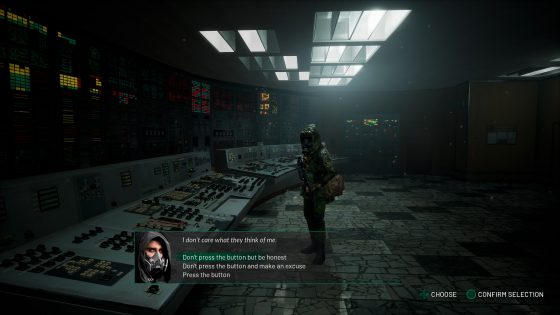
Out in the world, the game is played from the first person. You have your weapons and supplies along with your portal gun to get back to base and an environmental scanner that will alert you to deadly radiation levels along with scanning and letting you find items to scavenge. You’ll face off against heavily armed NAR troops patrolling along with dangerous monsters that are the result of the experiments and disaster that happened in Chernobyl. You’ll also experience visions of your lost love, Tatayana, and enter a bizarre alternate universe called the Fractal World. The mission structure and combat help make this more interesting and fun to me than some other games that emphasize survival and base building. I’m not really a fan of games that just drop you into a world and you have to gather resources to build stuff, the story and structure of Chernobylite are much more in my wheelhouse. If you’re looking for an interesting first-person RPG with some horror elements and survival/base-building, definitely check out Chernobylite, it’s out now on Steam, PS4, Xbox, GOG, and the Epic Games Store.
Rhythm of the Universe: Ionia (Zach): Available on Oculus, SteamVR and PSVR, Rhythm of the Universe: Ionia is a first person VR adventure where you travel through mysterious ruins and wilderness of Ionia, which feels very Avatar (James Cameron style) with vibrant plant life and strange and exotic creatures. The world of Ionia is in a state of war with an evil dark force called the Tritone trying to take over and burning everything in their path. This hurts the spiritual protector of Ionia, the Harpa, but two siblings, Allegro and Allegra, set out to save the Harpa and their world. If you played something like Vader Immortal in VR, Rhythm of the Universe feels similar as you navigate around via a teleportation system, do some climbing to navigate to new areas and then solve puzzles to progress. The teleporting works fine and the climbing is as good as any other game with a similar mechanic. So far there doesn’t seem to be any combat and the puzzles are unique in that they are mostly rhythm and music based. The first puzzle you encounter, for instance, is trying to match the tones being made by some nearby creatures on a marimba style instrument and it takes a while and some experimentation to figure out what keys match which notes. If you have a tin ear for music and tones, you might have a rough time with ROTU: Ionia.
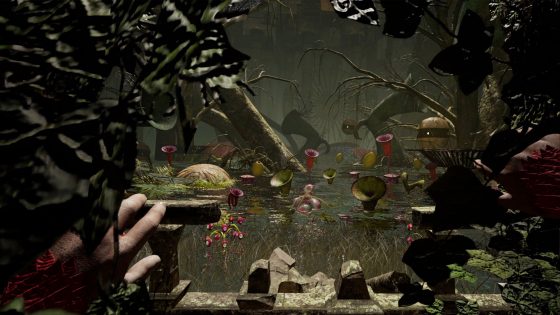
I was playing on an original Oculus Quest, which is definitely the most underpowered of the VR platforms that ROTU is out on. The graphics were a little rough in spots but obviously the more higher end and powerful PC/VR combo you have, the better it will look. The world is still interesting and unique even on the quest and it’s fun to just keep exploring and see what the next area holds or what strange creature you’ll encounter. The puzzles and their more musical leaning solutions are definitely interesting and sets it apart from other similar puzzle games inside or outside of VR. One other cool aspect of ROTU: Ionia is that a portion of each purchase gets donated to the Wildlife Warriors Worldwide charity, so while you help to save the world of Ionia, you’re helping a bit to save our world and it’s creatures as well. If you have a VR headset, Rhythm of the Universe: Ionia is definitely worth checking out for some solid puzzle solving in a unique and interesting world.



